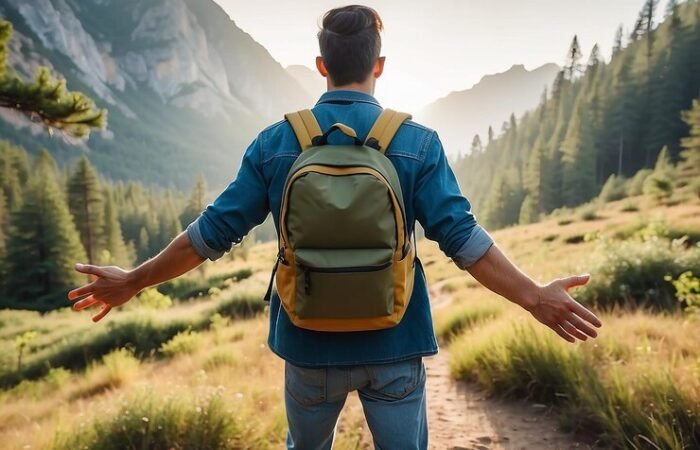So, you’re thinking about going backpacking, huh? Well, you’ve come to the right place! Backpacking is an exhilarating way to immerse yourself in nature, challenge your limits, and create unforgettable memories. But before you hit those trails, especially if you’re a first-timer, there’s some essential knowledge you’ll need to make your backpacking trip a success.
In this comprehensive guide, we’ll cover everything from planning your adventure to choosing the right backpacking gear and staying safe on the trail. By the end, you’ll be ready to sling that pack over your shoulders and embark on an incredible journey through the great outdoors.
Key Takeaways:
- Proper planning is crucial for a enjoyable and safe backpacking trip
- Investing in quality “big three” gear (backpack, shelter, tent) is worth it
- Safety should always be the top priority when backpacking
- Backpacking builds resilience, fosters appreciation for nature
So, let’s dive into the exciting world of backpacking!
Planning Your Backpacking Trip
Look, backpacking ain’t no walk in the park (pun totally intended). It’s really an adventure that requires some serious planning and preparation. Trust me, you don’t want to find yourself miles from nowhere without the essentials or a solid plan.
First things first, you’ll need to choose your trail. Consider factors like the distance, elevation gain, and overall difficulty level. As a beginner, it’s best to start with well-traveled, clearly marked trails close to home. Once you’ve got some experience under your belt, you can level up to more challenging routes.
Next up, check those weather forecasts like a hawk. Backpacking in a blizzard or scorching heat is a recipe for disaster (and really bad blisters). Aim for mild, dry conditions, at least for your first few trips.
Finally, be honest with yourself about your physical condition. Backpacking is no joke – you’ll be carrying everything you need on your back over rugged terrain. If you’re not an avid hiker, spend some time building up your endurance beforehand.
With your trail, weather, and physical prep squared away, it’s time to think about gear. Luckily, there are plenty of resources out there to help you build the perfect backpacking checklist. REI’s expert advice is a great place to start.
Backpacking Gear Essentials
When it comes to backpacking gear, there’s one mantra to live by: invest in the “big three” – your backpack, shelter, and sleeping bag. These are the items that’ll keep you comfortable and safe on the trail, so it’s worth splurging a bit.
For backpacks, look for something lightweight yet durable, with a supportive frame and ample storage space. Osprey and REI are two top brands known for their high-quality backpacking packs.
As for shelters, you’ll need to decide between a tent or hammock setup. Tents like the Nemo Dagger and Big Agnes Copper Spur are incredibly popular for their lightweight, weather-resistant designs. If you prefer hammock camping, be sure to pack the appropriate straps, rainfly, and insulation.
Your sleeping bag is another crucial piece of gear. Go for a three-season bag rated for the expected temperatures, and pay attention to fill (down is warmest but pricier). Don’t forget a sleeping pad too – it’ll insulate you from the cold ground and provide much-needed cushioning.
Of course, there’s plenty of other essential backpacking gear to consider, from cookware and water filters to navigation tools and first aid kits. But with your “big three” squared away, you’ll be well on your way to ultralight backpacking bliss.
Safety Precautions and Emergency Preparedness
Now, as exciting as backpacking is, it’s really important to prioritize safety every step of the way. The wilderness can be unforgiving, so being prepared for emergencies is an absolute must.
First up, pack a solid first aid kit stocked with bandages, medications, and supplies to treat minor injuries. Throw in some moleskin for blisters too – trust me, you’ll be grateful. A water purification system like a filter or tablets is also essential for accessing clean drinking water from natural sources.
While we’re on the topic of water, dehydration is no joke when you’re exerting yourself on the trail. Make sure to pack enough water for your trip, and drink frequently to avoid that dreaded cottonmouth feeling. Energy bars, jerky, trail mix, and dried fruit are great snack options to keep you fueled too.
Another major backpacking hazard? Getting lost or injured far from help. That’s why it’s wise to carry navigation tools like a map, compass, and even a personal locator beacon. Learn how to use them properly before your trip, and never go without them on the trail.
Lastly, pack the right clothing and layers to handle any weather Mother Nature throws your way. Dressing in moisture-wicking fabrics like wool or synthetic is key, and don’t forget extras like a rain jacket, warm hat, and gloves. Hypothermia is a real risk if you get wet and cold.
With the right safety gear, knowledge, and precautions, you can backpack with confidence knowing you’re prepared for the unexpected.
Additional Tips for Beginner Backpackers
Okay, so you’ve got the planning, gear, and safety basics down – but there’s still more to cover if you want to backpack like a total pro. Here are some extra tips and strategies to make your journey smoother:
First, always stick to the principles of Leave No Trace. That means packing out all your trash, staying on designated trails, respecting wildlife, and leaving campsites exactly as you found them. It’s the backpacker’s duty to protect these natural spaces.
Next, consider going ultralight or even backpacking on a budget to save weight and money. Only pack the essentials you absolutely need rather than luxury items. Look into lightweight gear made from materials like nylon too. Every ounce counts when you’re carrying it all!
When you’re actually out on the trail, listen to your body. If the mileage or elevation gain is too much, slow down and rest as needed. Blisters, muscle cramps, and fatigue will hit much harder with a heavy pack on your back. Speaking of packs, practice good loading techniques by keeping heaviest items closest to your back.
Lastly, be prepared for some not-so-glamorous moments. Dealing with mother nature’s calls, getting caught in the rain, and fending off pesky critters are all part of the quintessential backpacking experience. Embrace the grit and discomfort – it’ll make the stunning views that much sweeter!
Conclusion
There you have it, folks – everything you need to know to plan an epic backpacking adventure as a total newbie. While it does require some solid preparation and precautions, backpacking is an incredibly rewarding way to disconnect from the hustle of everyday life and reconnect with the great outdoors.
By mastering the basics of planning, learning about essential backpacking gear, and prioritizing safety, you’ll be setting yourself up for the journey of a lifetime. And who knows? You might just catch the backpacking bug and find yourself hiking farther, higher, and wilder with every trip.
So what are you waiting for? Start planning that first backpacking trip today – the trails are calling! Get out there, take on that challenge, and make some incredible memories along the way. The world is yours to explore, one step at a time. Happy trails!








No Comment! Be the first one.